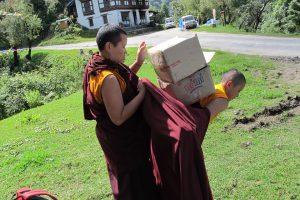The Land of the Thunder Dragon, is an extraordinary place. Vast and impressive fortresses, known as Dzongs,  dominate Bhutan’s landscape – from the wide subtropical valleys in the south to the Himalayan mountain ranges of the north. It is a deeply Buddhist land where you can join pilgrims as they look for the footprints of saints in a rockface, or explain monastery history in terms of flying tigers and unruly demons.
dominate Bhutan’s landscape – from the wide subtropical valleys in the south to the Himalayan mountain ranges of the north. It is a deeply Buddhist land where you can join pilgrims as they look for the footprints of saints in a rockface, or explain monastery history in terms of flying tigers and unruly demons.
Bhutan has thousands of monks and nuns dedicating their lives to service. I was excited to learn that we will have the honor to visit the Bhutan Nuns Foundation (BNF), a non -profit stated by Dr. Tashi Zangmo under the patronage of Her Majesty, the Queen Mother, Ashi Tshering Yangdon Wangchuck.
A visit to the foundation and possibly spending time at the nunnery piqued my interest to learn more about the nunneries in Bhutan. The foundation’s website provides an insight into the life of Bhutan’s Buddhist nuns, who mostly live under harsh conditions, have little education and little resources.
 According to the website unlike the monasteries for men and boys that are beneficiaries of state or private support, nunneries in Bhutan receive no government funding. Private and community support is also extremely limited leaving the girls and women in many nunneries vulnerable and neglected. It is sad that so little of their potential to serve society and contribute to its collective happiness is ever realized.
According to the website unlike the monasteries for men and boys that are beneficiaries of state or private support, nunneries in Bhutan receive no government funding. Private and community support is also extremely limited leaving the girls and women in many nunneries vulnerable and neglected. It is sad that so little of their potential to serve society and contribute to its collective happiness is ever realized.
In Bhutan, there are several thousand nuns within and outside nunneries. Many women between the ages of 12 and 50 have attended a nunnery as a form of traditional learning. Many younger women join the nunneries as an alternative means of achieving an education. A significant number of girls become nuns because their parents could not afford to send all their children to the formal school system.
Some girls who drop out of the formal school system eventually end up in the nunneries hoping to continue learning  in the traditional way. Others join simply because they wish to follow a Buddhist spiritual path marked by a life of meditation, devotion to Buddhist studies, peace and harmony. Finally, older women often join the community of nuns (Sangha) to seek a second chance in life through learning and devotion. Overall, women both young and old join nunneries because they are passionate about studying Buddhism, and have a desire to live a peaceful and meaningful life that brings balance and wisdom to a rapidly changing and increasingly unsustainable world.
in the traditional way. Others join simply because they wish to follow a Buddhist spiritual path marked by a life of meditation, devotion to Buddhist studies, peace and harmony. Finally, older women often join the community of nuns (Sangha) to seek a second chance in life through learning and devotion. Overall, women both young and old join nunneries because they are passionate about studying Buddhism, and have a desire to live a peaceful and meaningful life that brings balance and wisdom to a rapidly changing and increasingly unsustainable world.
Nuns also play a crucial role in preserving Bhutan’s traditions and culture, and thus are critical to achieving Gross National Happiness. This philosophy in essence is all about balancing material wants with spiritual needs.
As I read that nearly all of Bhutan’s nunneries have poor living conditions and provide little to no basic education my heart was moved to tears. After having dedicated their entire life to spirituality and service, these beautiful nuns had little or no access to furthering their spiritual education.
There are many roads to love peace and harmony, service through sharing simple yet practical self- help techniques is definitely one of them. Using Tao Calligraphy practices for self-nourishment and healing is another one. More ideas and ways of supporting the nunneries and the nuns will develop as we experience their way of living first hand. As we humble ourselves to learn from them, inspiration and creative ideas will surface on further collaboration!
 With love peace and harmony
With love peace and harmony
Firuzan
@firuzan.mistry
The post Behind the prayer flags : Bhutan’s Nunneries appeared first on Love Peace Harmony.
